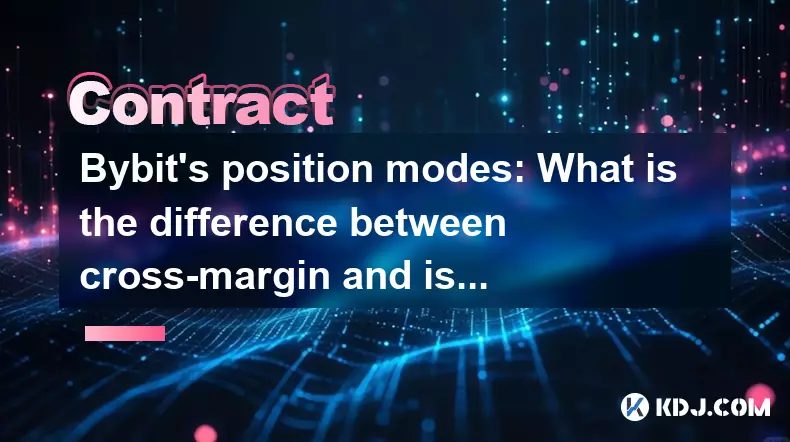-
 bitcoin
bitcoin $109667.069529 USD
-3.03% -
 ethereum
ethereum $3936.685804 USD
-4.07% -
 tether
tether $1.000493 USD
0.01% -
 xrp
xrp $2.771823 USD
-4.74% -
 bnb
bnb $957.805027 USD
-5.34% -
 solana
solana $196.735100 USD
-6.68% -
 usd-coin
usd-coin $0.999727 USD
-0.01% -
 dogecoin
dogecoin $0.227355 USD
-5.12% -
 tron
tron $0.335205 USD
-0.81% -
 cardano
cardano $0.779256 USD
-3.59% -
 ethena-usde
ethena-usde $0.999900 USD
-0.06% -
 hyperliquid
hyperliquid $42.492095 USD
-6.61% -
 chainlink
chainlink $20.501853 USD
-4.34% -
 avalanche
avalanche $28.952606 USD
-11.21% -
 stellar
stellar $0.356038 USD
-3.93%
Bybit's position modes: What is the difference between cross-margin and isolated margin?
Bybit offers cross and isolated margin modes: isolated limits risk per trade, while cross uses total equity as collateral, affecting liquidation and leverage differently.
Sep 22, 2025 at 01:18 am

Understanding Bybit's Margin Systems
1. Bybit offers two distinct position modes for traders engaging in futures contracts: cross-margin and isolated margin. These systems define how margin is allocated and managed within a trading account, directly influencing risk exposure and potential liquidation scenarios. Each mode caters to different trading styles, risk tolerances, and strategic objectives.
2. In cross-margin mode, the entire available balance in a trader’s wallet acts as collateral for open positions. This means that all funds are pooled together to prevent liquidation, increasing the buffer against adverse price movements. It provides greater flexibility during high volatility but exposes the full account equity to risk if a position moves sharply against the trader.
3. Isolated margin, on the other hand, restricts the margin allocated to a specific position to a predetermined amount. Traders set this value manually, effectively capping their maximum loss on that trade to the assigned margin. This method enhances control over individual trade risks and is preferred by those who apply strict capital management rules.
4. The choice between these modes impacts leverage application. In isolated margin, leverage is applied directly to the allocated margin, allowing traders to fine-tune exposure. Cross-margin dynamically adjusts effective leverage based on floating P&L and total equity, which can lead to unpredictable shifts under rapid market changes.
5. Liquidation mechanics differ significantly. Under isolated margin, once the assigned margin is depleted, the position is closed automatically without affecting other trades. In cross-margin, liquidation only occurs when the entire account balance is insufficient to maintain the position, potentially preserving trades longer but risking broader equity drawdown.
Risk Management Implications
1. Using isolated margin allows traders to compartmentalize risk. Each position operates independently, making it easier to assess performance and exposure per trade. This structure supports disciplined strategies where consistency and predictability are prioritized.
2. Cross-margin introduces interdependence among positions. Gains in one contract can support losing positions elsewhere, delaying liquidation and offering breathing room during temporary downturns. However, this interconnectedness may mask deteriorating conditions until overall equity is critically low.
3. Traders employing hedging strategies often favor isolated margin because offsetting positions do not share margin resources. This prevents one side of a hedge from consuming equity needed for the other, maintaining balance between long and short exposures.
4. For novice traders, isolated margin reduces complexity. Knowing exactly how much capital is at stake per trade simplifies decision-making and helps avoid over-leveraging the entire portfolio unintentionally.
5. Advanced traders might use cross-margin during trending markets to maximize holding power. When confidence in directional movement is high, leveraging total equity can extend survival through minor reversals without requiring additional top-ups.
Operational Flexibility and Trade Adjustments
1. Isolated margin permits manual adjustment of margin levels mid-trade. Traders can add or reduce margin to alter liquidation prices and leverage ratios dynamically. This feature supports active risk tuning in response to evolving market signals.
2. Cross-margin does not allow direct margin adjustments since the system automatically utilizes available balance. While this reduces manual intervention, it also removes granular control over position-specific parameters.
3. Position sizing becomes more calculable with isolated margin. Since the risk is fixed upfront, position scale correlates directly with entry price, stop-loss levels, and allocated capital, enabling precise expectancy modeling.
4. In fast-moving markets, cross-margin can trigger sudden margin calls indirectly. If multiple positions decline simultaneously, the cumulative effect on equity may force liquidations even if some trades remain viable.
5. Portfolio diversification benefits from isolated settings when managing multiple instruments. Each market can have tailored margin allocations based on volatility, correlation, and conviction level, avoiding uniform treatment across disparate assets.
Frequently Asked Questions
Can I switch between cross-margin and isolated margin on Bybit?Yes, traders can switch between modes at any time, provided they have no open positions using the mode being changed. The platform requires closure or modification of existing trades before switching to ensure consistency in margin calculation.
Does cross-margin increase my chances of survival during drawdowns?It can, because the entire account balance serves as a buffer. As long as total equity remains above maintenance margin requirements, positions stay active even if individual contracts show losses. However, this also means larger portions of capital are exposed.
Is isolated margin safer than cross-margin?Safer depends on context. Isolated margin limits per-trade risk and enhances control, making it suitable for structured approaches. Cross-margin offers resilience through shared equity but demands vigilant monitoring to prevent widespread impact from failing positions.
How does Bybit calculate liquidation price under each mode?In isolated margin, the liquidation price is determined solely by the entry price, leverage, fees, and assigned margin. In cross-margin, it factors in total account equity, unrealized P&L across all positions, and funding rates, resulting in a more complex and variable threshold.
Disclaimer:info@kdj.com
The information provided is not trading advice. kdj.com does not assume any responsibility for any investments made based on the information provided in this article. Cryptocurrencies are highly volatile and it is highly recommended that you invest with caution after thorough research!
If you believe that the content used on this website infringes your copyright, please contact us immediately (info@kdj.com) and we will delete it promptly.
- Big Rocking Horse, Coin, and Ice Cream: An Aussie Icon's Sweet Ride
- 2025-09-26 10:45:16
- Pi Network, Price Forecast, and the Meme Market: A New York Minute
- 2025-09-26 10:25:14
- AIXA Miner: Revolutionizing Bitcoin Mining with Cloud Solutions
- 2025-09-26 10:45:16
- Mid-Cap Altcoins: Crypto Buys with Breakout Potential
- 2025-09-26 10:50:01
- BullZilla Presale: Riding the Crypto Wave in September 2025
- 2025-09-26 10:50:01
- Litecoin ETF Buzz, XRP Breakout Dreams, and BlockDAG's Deployment: Crypto's Wild West in '25
- 2025-09-26 10:50:01
Related knowledge

How do I enable the "scalping-only" mode for Cardano (ADA) contracts?
Sep 24,2025 at 03:19am
Understanding Scalping Strategies in Crypto Derivatives1. Scalping in cryptocurrency trading refers to executing multiple short-term trades within min...

What is the maximum position limit for Cardano (ADA) contracts?
Sep 23,2025 at 11:00pm
Understanding ADA Futures and Derivatives Market Structure1. Cardano (ADA) futures contracts are offered by several major cryptocurrency derivatives e...

What is the maker fee for Cardano (ADA) contracts?
Sep 26,2025 at 09:01am
Understanding Maker Fees in Cardano (ADA) Contracts1. The concept of maker fees applies broadly across decentralized exchanges and smart contract plat...

How can I view open interest in Cardano (ADA) contracts?
Sep 24,2025 at 07:36am
Understanding Open Interest in Cardano Derivatives1. Open interest refers to the total number of outstanding derivative contracts, such as futures or ...

What is the function of the insurance fund in Cardano (ADA) contracts?
Sep 24,2025 at 02:18am
Understanding the Role of Insurance Funds in Cardano Smart Contracts1. The insurance fund within Cardano's ecosystem is not a native feature directly ...

How can I view historical transaction records for Cardano (ADA) contracts?
Sep 24,2025 at 04:01pm
Understanding Cardano's On-Chain Data Structure1. Cardano operates on a proof-of-stake blockchain that records all transactions in blocks secured thro...

How do I enable the "scalping-only" mode for Cardano (ADA) contracts?
Sep 24,2025 at 03:19am
Understanding Scalping Strategies in Crypto Derivatives1. Scalping in cryptocurrency trading refers to executing multiple short-term trades within min...

What is the maximum position limit for Cardano (ADA) contracts?
Sep 23,2025 at 11:00pm
Understanding ADA Futures and Derivatives Market Structure1. Cardano (ADA) futures contracts are offered by several major cryptocurrency derivatives e...

What is the maker fee for Cardano (ADA) contracts?
Sep 26,2025 at 09:01am
Understanding Maker Fees in Cardano (ADA) Contracts1. The concept of maker fees applies broadly across decentralized exchanges and smart contract plat...

How can I view open interest in Cardano (ADA) contracts?
Sep 24,2025 at 07:36am
Understanding Open Interest in Cardano Derivatives1. Open interest refers to the total number of outstanding derivative contracts, such as futures or ...

What is the function of the insurance fund in Cardano (ADA) contracts?
Sep 24,2025 at 02:18am
Understanding the Role of Insurance Funds in Cardano Smart Contracts1. The insurance fund within Cardano's ecosystem is not a native feature directly ...

How can I view historical transaction records for Cardano (ADA) contracts?
Sep 24,2025 at 04:01pm
Understanding Cardano's On-Chain Data Structure1. Cardano operates on a proof-of-stake blockchain that records all transactions in blocks secured thro...
See all articles










































































